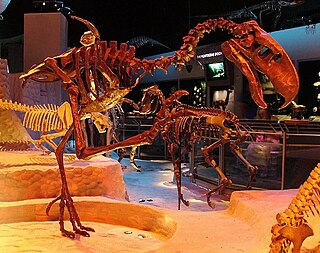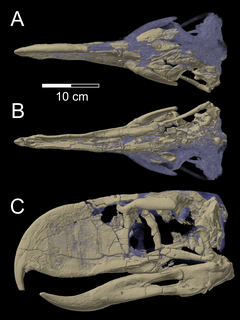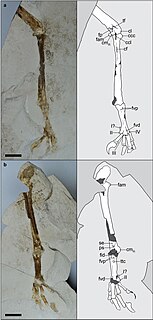
Rheidae is a family of flightless ratite birds which first appeared in the Paleocene. It is today represented by the sole living genus Rhea, but also contains several extinct genera.

Phorusrhacids, colloquially known as terror birds, are an extinct clade of large carnivorous flightless birds that were one of the largest species of apex predators in South America during the Cenozoic era; their conventionally accepted temporal range covers from 62 to 1.8 million years (Ma) ago.

Vegavis is a genus of extinct bird that lived during the Late Cretaceous of Antarctica, some 68 to 66 mya. Among modern birds, most studies show that Vegavis is most closely related to ducks and geese (Anatidae), but it is not considered to be a direct ancestor of them, although other studies question these results.

Phorusrhacos is an extinct genus of giant flightless terror birds that inhabited Argentina during the Miocene epoch. Phorusrhacos was one of the dominant land predators in South America at the time it existed. It is thought to have lived in woodlands and grasslands.

Titanis is an extinct genus of giant flightless terror birds that inhabited North America during the early Pliocene to early Pleistocene epochs. The generic name, Titanis, refers to the titans, Ancient Greek gods that preceded the Twelve Olympians, in allusion to the bird's size. The specific name, T. walleri, honors the holotype's collector, Benjamin I. Waller, an avocational underwater archaeologist. Titanis was thought to be carnivorous and most likely preyed on the many small mammals of the time period. This giant flightless bird was one of the most efficient predators of its time in North America.

Andalgalornis is a genus of flightless predatory birds of the extinct family Phorusrhacidae that lived in Argentina. The type and only species is A. steulleti.

Cramauchenia is an extinct genus of litoptern South American ungulate. Cramauchenia was named by Florentino Ameghino. The name has no literal translation. Instead, it is an anagram of the name of a related genus Macrauchenia. This genus was initially discovered in the Sarmiento Formation in the Chubut Province, in Argentina, and later it was found in the Chichinales Formation in the Río Negro Province and the Cerro Bandera Formation in Neuquén, also in Argentina, in sediments assigned to the SALMA Colhuehuapian. In 1981 Soria made C. insolita a junior synonym of C. normalis. A specimen of C. normalis was described in 2010 from Cabeza Blanca in the Sarmiento Formation, in sediments assigned to the Deseadan SALMA.

Eudromia is a genus of birds in the tinamou family. This genus comprises two crested members of this South American family.

Nothura is a genus of birds in the tinamou family. This genus comprises five members of this South American family.

Gastornithiformes were an extinct order of giant flightless fowl with fossils found in North America, Eurasia, and possibly Australia. Members of Gastornithidae were long considered to be a part of the order Gruiformes. However, the traditional concept of Gruiformes has since been shown to be an unnatural grouping.

Kelenken is a genus of giant flightless predatory birds of the extinct family Phorusrhacidae, or "terror birds". The type and only species is K. guillermoi, first formally described in 2007 after the find in 1999. It is the largest known member of the family.

Psilopterus is an extinct genus of phorusrhacid from the Middle Oligocene to Late Pleistocene of Argentina and Uruguay. Compared to other phorusrhacids, members of the genus are both relatively gracile and diminutive, and include the smallest known species of terror bird: with the head raised P. bachmanni was 70–80 centimeters (2.3–2.6 ft) in height and weighed about 5 kilograms (11 lb), while the largest members of the genus were only about 7 kilograms (15 lb). The birds resemble the modern cariama, except with a heavier build and considerably smaller wings. The strong morphological similarity between the claws of the predatory cariama and Psilopterus, both of which are sharp, curved, and laterally compressed, may indicate they were used to strike prey. In contrast to the other, larger terror birds, Tonni and Tambussi also suggested Psilopterus could use their claws to climb trees, and could even fly, but this has been rejected in more recent literature. Fossil finds in Uruguay indicate the genus may have survived until 96,040 ± 6,300 years ago, millions of years after the larger phorusrhacids became extinct.

Llallawavis scagliai is a large, extinct predatory bird from Pliocene Argentina. Its fossil is the most complete fossil of a phorusrhacid yet found.

The Odontoanserae is a proposed clade that includes the family Pelagornithidae and the clade Anserimorphae. The placement of the pseudo-toothed birds in the evolutionary tree of birds has been problematic, with some supporting the placement of them near the orders Procellariformes and Pelecaniformes based on features in the sternum.
Pseudoseisuropsis is a genus of extinct birds in the ovenbird family from the Pleistocene of Argentina and Uruguay. The genus was described in 1991 based on disarticulated skeletal elements and a nearly-complete skull. Although originally believed to be closely related to the extant genus Pseudoseisura, phylogenetic analyses suggested a more basal origin within the family.
The Ituzaingó Formation, in older literature also described as Entre Ríos or Entrerriana Formation, is an extensive geological formation of Late Miocene age in the Paraná Basin of the Corrientes, Santa Fe and Entre Ríos Provinces in Mesopotamia, northeastern Argentina. The formation comprises mudstones, cross-bedded sandstones and conglomerates deposited in a fluvio-deltaic environment and is renowned for the preservation of a rich fossil assemblage, including many mammals, birds, reptiles, fish, bivalves, foraminifera, ichnofossils and flora.

Conflicto antarcticus is a species of stem waterfowl whose fossils were found in the early Paleocene López de Bertodano Formation of Antarctica, the only species of its genus and the family Conflictonidae. It is characterized by it slender body and long legs, yet possesses a duck-like bill which indicates the form of beak evolved early in Anseriformes.

The Laguna del Hunco Formation or Laguna del Hunco Tuff is a localized Early Eocene fossiliferous geological formation of the Cañadón Asfalto Basin in central Patagonia, Argentina. The 170 metres (560 ft) thick formation comprises tuffaceous mudstones and sandstones deposited in a crater lake environment and crops out at Laguna del Hunco in the northwestern Chubut Province.

Ueekenkcoracias is an extinct genus of primobucconid bird in the order Coraciiformes from the Huitrera Formation of Patagonia. A relatively large member of the stem-Coracii, Ueekenkcoracias possessed a robust femur and stout tibiotarsus, with a strongly projected facies articularis medialis.
Chunga incerta is an extinct species of cariamid bird which inhabited the Pliocene of the central-eastern Southern Cone of South America. It belongs to the genus Chunga, today only represented by one species, Chunga burmeisteri.


















